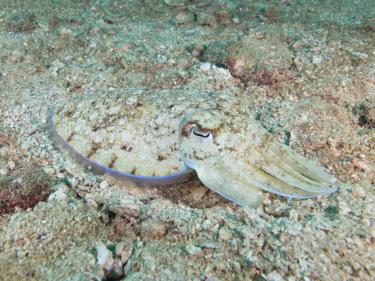Secrets of the infamous cousin of the octopus
Despite their name, Cuttlefish are in fact not fish, but rather, molluscs (4). Relatives of squid and octopi, cuttlefish are often forgotten and overshadowed by their more famous cousins (1). But despite their similarities, the cuttlefish distinguishes itself due to its unique appearance and ability to camouflage almost instantly.
Although they are colorblind, cuttlefish are masters of camouflage. In fact, the cuttlefish is so good at mimicking its surroundings that it is able to appear virtually invisible to both predators and prey alike (2). How is it able to so effectively camouflage?

This mollusc is able to control its appearance through manipulation of millions of pigment cells called chromatophores (3). Chromatophores contract and expand in order to produce the camouflage pattern intended (5). Cuttlefish scan their surroundings and infer based on evolutionary history which pattern would be best for the situation (5). They gain the ability to perform this type of “adaptive camouflage” from birth, indicating to scientists that the skill is likely innate and extremely necessary for their survival(5). In fact it is so helpful, that a cuttlefish spends 95% of its time in hiding from both predators and prey (6). Chromatophores are the pigment cells that help the cuttlefish to “hide” themselves, and are attached to muscles and directly linked to motor neurons (5). The motor neurons signal to the chromatophores to contract and release the appropriate pigment (5). When the muscles relax, the pigment is not displayed and the camouflage process stops (5). Cuttlefish have the ability to change texture as well as adapt their color to match the environment using papillae, raised bumps that can open or close to mimic various textures, improving their ability to blend in (2). Most impressive, they are very speedy in changing their appearance. In fact, they are one of the fastest camouflaging animals on the planet; a cuttlefish can achieve this level of deceit and sheer invisibility within less than a second (7).
Based on their color-changing abilities, one might think that the cuttlefish is a sort of “sea-cameleon” when, in truth, they are actually quite similar to insects as they don’t have true bones (3). And despite what the name may imply, the cuttlebone, for which the cuttlefish is named, is, in fact, not a bone at all (3). Cuttlebones are shells that are made of aragonite, a calcium carbonate material that allows cuttlefish to control their buoyancy (3). Cuttlebones have both gas and liquid chambers, and this shell is used to control their level in the water (3).

Along with the cuttlebone, cuttlefish have structures such as mantles and fins that allow for swim control (3). When needed, the cuttlefish is able to pull water into the mantle cavity and propell backwards (3). The fin, on the other hand, is a skirt-like structure, which allows for precise movements (3).
Not only are cuttlefish primed for swimming and catching prey, but they are also quite adept at fending away predators. Like octopi, cuttlefish use ink as a defensive mechanism. Brown ink squirts from their gills when distressed. The ink of the cuttlefish even has a color named after it,“sepia,” which describes a brown-ish hue which is related to the ink produced by the common cuttlefish species, Sepia Officinalis (3).
The cuttlefish is able to change color within less then a second, has incredibly precise buoyancy and movement control, and even has a color named after its ink. So, despite being the often overlooked cousin of the octopi, the cuttlefish is actually quite a remarkable and fascinating creature. So, whenever you’re swimming in the ocean, try to look out for the cuttlefish. Just keep this in mind: they may be hard to spot!
Citations:
- Britannica. (2021). Cuttlefish | Description, Anatomy, & Facts. Britannica. Retrieved from https://www.britannica.com/animal/cuttlefish
- Greenwood, V. (2021, July 12). Did a Cuttlefish Write This? New York Times. Retrieved from
- NOVA. (2021). Kings of Camouflage | Anatomy of a Cuttlefish. PBS. Retrieved from https://www.pbs.org/wgbh/nova/camo/anat-nf.html
- Spener, E. (2017, April 7). How to Tell the Difference Between a Squid and a Cuttlefish. Ocean Conservancy. Retrieved from https://oceanconservancy.org/blog/2017/04/07/how-to-tell-the-difference-between-squid-and-cuttlefish/
- Max-Planck-Gesellschaft. (2018, October 18). Elucidating Cuttlefish Camouflage. Max-Planck-Gesellschaft. Retrieved from https://www.mpg.de/12363924/1017-hirn-080434-elucidating-cuttlefish-camouflage
- National Geographic. (2021). Deadly Flamboyant Cuttlefish Puts on Flashy Display. National Geographic. Retrieved from https://www.nationalgeographic.com/animals/invertebrates/facts/cuttlefish
- Hanlon, R (2017, November 1). Nature’s Best and Fastest Camouflage. Divers Alert Network. Retrieved from https://dan.org/alert-diver/article/natures-best-and-fastest-camouflage/#:~:text=No%20creature%20on%20the%20planet,fast%20as%20a%20human%20eyeblink.

